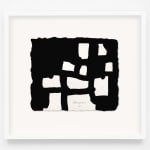Eduardo Chillida
Further images
The materiality of 'Lizardiren Leihoak' is as integral to its expression as its thematic essence. The use of Segundo Santos handmade paper imbues the artwork with an organic quality, its textured surface reflecting the tactile experience of space. This small-scale etching, intimate in its dimensions, contrasts with Chillida's larger sculptural works, yet maintains their intensity and depth. The delicate interplay of light and shadow, carved onto the paper's surface, reflects a sensitivity to medium that enhances the viewer's experience of the piece. The handmade paper, irregular and unique, becomes a landscape unto itself, a microcosm where Chillida's abstract windows open into new dimensions of contemplation.
The title 'Lizardiren Leihoak,' or 'Lizardi's Windows,' further deepens the interpretive layers of the etching, paying homage to the Basque poet Xabier de Lizardi (1896 - 1933). Just as Lizardi's modernist poetry carves out new linguistic spaces and gives form to Basque cultural identity, Chillida's windows offer a visual poetics that frames emptiness as substance. The poet’s exploration of identity and language mirrors Chillida's own search for spatial essence, both artists engaging in a dialogue that transcends their mediums. This etching, a harmonious blend of form and space, material and void, becomes an allegory for the communicative potential of art, much like Lizardi's verses, to reach beyond the confines of physical form to touch the spirit of place and culture. In 'Lizardiren Leihoak,' Chillida does not merely create; he reveals, much as a poet reveals the unseen through words, crafting a nexus of artistic kinship across time and discipline.
NOTES
This artwork is signed and inscribed AP (artist's proof) in pencil.
Published by Galerie Beyeler, Basel, and printed by Taller Hatz, San Sebastián.
Provenance
Galerie Beyeler, BaselPrivate collection, Europe
Private collection, New York






